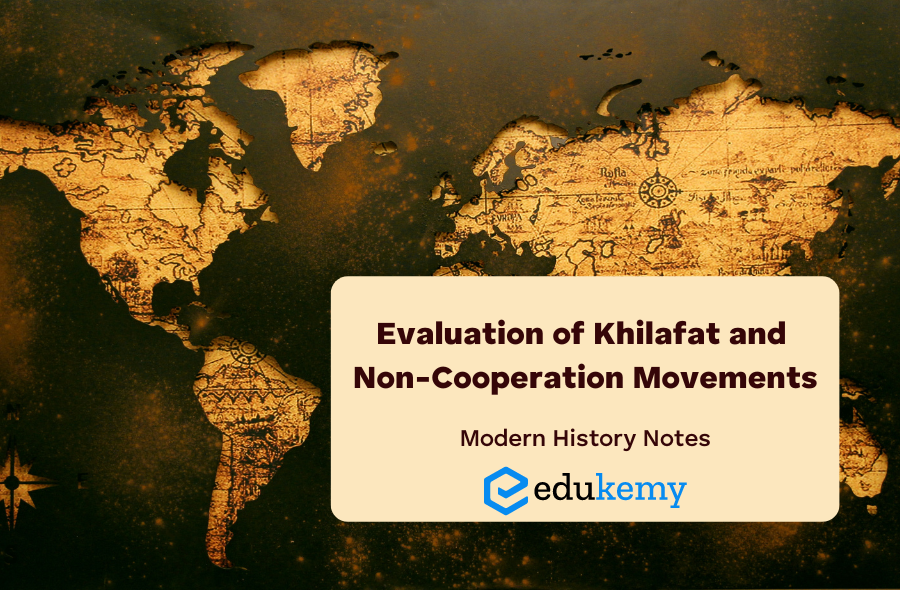
The Khilafat and Non-Cooperation movements had several significant outcomes and impacts on the Indian freedom struggle. Here is an evaluation of these movements:
- Mobilization and Inclusion: The movements successfully mobilized a diverse range of people, including urban Muslims, artisans, peasants, students, women, and traders. This widespread participation brought nationalist sentiments to every part of the country and expanded the reach of the national movement. It helped in politicizing various sections of society and bringing them into the fold of the struggle for independence.
- Revolutionary Flavour: The mass mobilization and politicization of millions of people gave the national movement a revolutionary character. It created a sense of unity and common purpose among the participants, fostering a collective spirit of resistance against colonial rule. The movements challenged the existing power structures and advocated for radical change in the socio-political landscape.
- Debunking Colonial Myths: The movements played a crucial role in debunking two key myths propagated by colonial rule. The first myth, that British rule was in the best interests of Indians, was challenged through the economic critique put forth by moderate nationalists. The Khilafat and Non-Cooperation movements further exposed the exploitative nature of colonial rule, thereby discrediting the notion that it was beneficial for the Indian population. The second myth, that British rule was unbreakable, was challenged through the mass struggle of Satyagraha, which demonstrated the power of nonviolent resistance in confronting and resisting colonial authority.
- Weakening of Fear: The participation of the masses in the movements played a significant role in diminishing the fear that had been ingrained in the Indian population regarding colonial rule. The demonstrations of unity, nonviolent resistance, and collective action instilled a sense of confidence and defiance among the people, eroding their fear of the powerful repressive machinery of colonial rule.
Overall, the Khilafat and Non-Cooperation movements had a transformative impact on the Indian freedom struggle. They mobilized and included various sections of society, challenged colonial myths, and instilled a sense of confidence and resistance among the masses. These movements laid the foundation for future struggles and became a significant chapter in India’s journey towards independence.
FAQs
1. What were the objectives of the Khilafat Movement?
- The Khilafat Movement aimed to protest against the dismantling of the Ottoman Caliphate by the Allied Powers after World War I.
- Its primary objective was to safeguard the interests of Muslims worldwide, particularly the preservation of the Ottoman Caliphate, which was considered as a symbol of Muslim unity and identity.
2. How did the Non-Cooperation Movement impact Indian society?
- The Non-Cooperation Movement, initiated by Mahatma Gandhi in 1920, aimed to resist British rule through nonviolent means.
- It saw widespread participation from various sections of Indian society, including peasants, workers, students, and even some members of the British Indian Army.
- The movement provided a platform for Indians to unite against British oppression and instilled a sense of national pride and unity, fostering a spirit of self-reliance and self-governance.
3. What were the major strengths of the Khilafat Movement?
- The Khilafat Movement brought together Muslims from different parts of the Indian subcontinent, transcending regional and sectarian divides.
- It provided a platform for political mobilization among Indian Muslims and enabled them to voice their concerns on a global stage.
- The movement garnered international attention and support, particularly from the Muslim world, which helped in amplifying its impact and significance.
4. What were the limitations of the Non-Cooperation Movement?
- The Non-Cooperation Movement faced challenges in maintaining nonviolent discipline, with instances of violence and sabotage occurring in some areas.
- The sudden withdrawal of Indian participation in governmental institutions led to administrative chaos and a breakdown of law and order in certain regions.
- The movement’s suspension in 1922 following the Chauri Chaura incident marked a setback, leading to disillusionment among some supporters and a loss of momentum.
In case you still have your doubts, contact us on 9811333901.
For UPSC Prelims Resources, Click here
For Daily Updates and Study Material:
Join our Telegram Channel – Edukemy for IAS
- 1. Learn through Videos – here
- 2. Be Exam Ready by Practicing Daily MCQs – here
- 3. Daily Newsletter – Get all your Current Affairs Covered – here
- 4. Mains Answer Writing Practice – here

